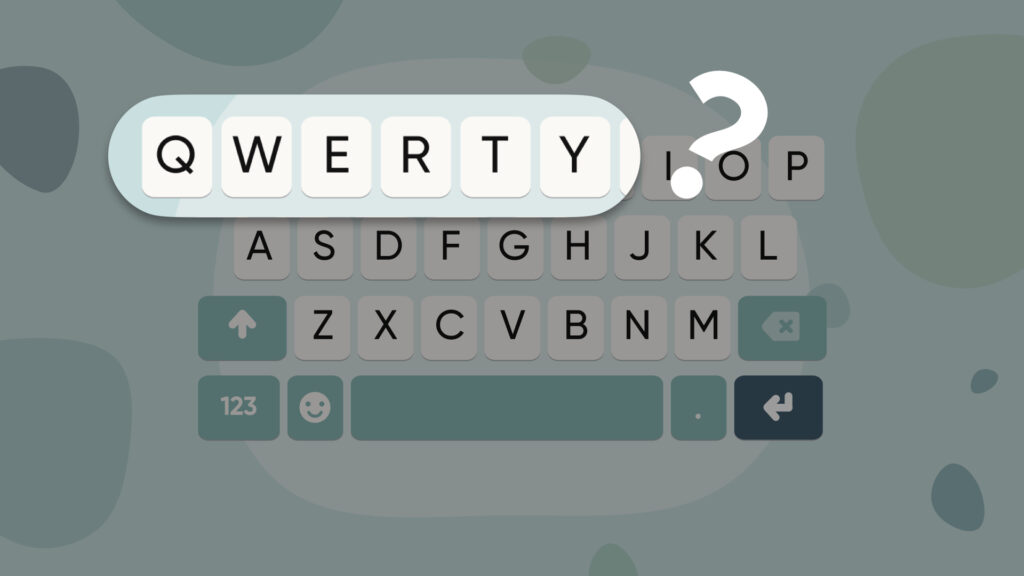Table of Contents

Before the advent of modern computing, there was the mechanical typewriter—a revolutionary invention in its time. The QWERTY layout, named after the first six letters on its top letter row, was designed by Christopher Latham Sholes in the 1870s. Originally developed to address the mechanical challenges of early typewriters, the QWERTY arrangement did not emerge from a desire for optimal typing efficiency. Rather, it was a pragmatic solution to prevent jamming: by spacing out frequently used letter combinations, Sholes ensured the typebars—mechanical arms striking the paper—would be less likely to clash, thereby increasing the reliability of the machine.
Over time, the layout became deeply embedded in American and global culture through widespread adoption in both commercial and personal use. The success of QWERTY can be largely attributed to early network effects; as typists, businesses, and educational institutions standardized on QWERTY technology, it became the baseline for all subsequent innovations in typing and text input. Even as alternate designs emerged, the inertia of a well-entrenched system ensured that QWERTY would not only survive but thrive.
The Enduring Influence of the Education System
One of the most striking aspects of the QWERTY layout’s longevity is its deep-seated integration into educational curricula around the world. From elementary schools to professional typing courses, QWERTY is taught as the definitive method for learning to type. Several critical factors highlight this phenomenon:
Early Adoption and Familiarity
From a young age, students are introduced to computers and keyboards loaded with the QWERTY configuration. As digital literacy becomes increasingly important, the educational system has adopted this layout almost universally. Since the standard keyboards in schools—at home and in public libraries—are based on QWERTY, children grow accustomed to its specific key placements and muscle memory develops accordingly. This early and consistent exposure creates an ingrained familiarity that is difficult to alter later in life.
Curricular Inertia
Educational syllabi and standardized testing systems are all based on the QWERTY keyboard’s setup. Because learning materials, computer-based tests, and even online educational platforms are optimized for the QWERTY layout, any attempt to shift to an alternative configuration (such as Dvorak or Colemak) would require significant changes not only in teaching methods but also in widely used educational and standardized materials. The logistical and financial hurdles associated with such a paradigm shift reinforce the continuing dominance of QWERTY.
Unified Global Standard
Despite the increasing diversity in learning methods and languages, QWERTY has maintained its position as a global standard. Its predictable layout and focus on facilitating a smooth learning curve have made it the default choice for many non-native speakers learning English and other languages that use the Latin alphabet. The global uniformity provides a huge advantage in our interconnected educational systems, making alternative keyboard layouts seem less appealing.
Digital Learning Tools and Software
A host of educational technologies—ranging from typing tutors to computer-assisted language learning platforms—are designed with the QWERTY layout in mind. The abundance of software tools built around QWERTY reinforces its use; it’s simply easier for educators and developers to stick with the established system than to invest in creating new platforms for an alternative layout that might not achieve universal adoption.
The adherence to QWERTY in education has profound implications. The ubiquity and normalization of the layout ensure that even as new devices and interfaces emerge, the foundational skills of text input remain rooted in QWERTY. This topic sets the stage for understanding why, even as we move into realms like VR (Virtual Reality), AR (Augmented Reality), and XR (Extended Reality), QWERTY virtual keyboards continue to be a go-to solution.
Why Alternatives to QWERTY Have Struggled
Over the years, the QWERTY layout has not been without its critics. Alternative keyboard designs, such as Dvorak and Colemak, were developed with the promise of increased typing efficiency and reduced finger strain. However, despite their theoretical advantages, these layouts have not become mainstream. Let’s explore some of the key reasons behind this phenomenon:
Entrenched Habit and Muscle Memory
One of the most formidable barriers to the adoption of any new keyboard layout is muscle memory. Experienced typists have spent years, sometimes decades, mastering the QWERTY system. Altering that deeply ingrained habit requires significant time and effort—a costly investment for individuals and organizations alike. The potential productivity loss during the transition makes employers and users reluctant to adopt alternatives.
Lack of Comprehensive Support
The QWERTY layout is supported by nearly every computer operating system, mobile device, and piece of software. In contrast, alternatives like Dvorak and Colemak often face compatibility issues or require explicit changes to settings, leading to frustration among users who expect seamless functionality. The path of least resistance always tends toward the status quo.
Limited Perceived Benefit
Despite studies suggesting that alternative layouts can lead to marginal improvements in typing speed and ergonomics, many users do not perceive these gains as sufficient to justify the inconvenience of a switch. The average typist’s daily challenges do not always warrant an overhaul of a working system. Without an overwhelmingly clear benefit, both individuals and institutions continue to rely on QWERTY.
Economic Inertia
Changing the standard keyboard layout would have significant economic implications. The costs associated with retraining personnel, redesigning manufacturing processes, and rewriting software support are nontrivial. As a result, businesses and educational institutions prefer to stick with the familiar and well-supported QWERTY layout rather than invest in an unproven alternative.
Market Dominance and Network Effects
The “network effect” plays a crucial role in the continued dominance of QWERTY. With billions of users worldwide, a change in the standard keyboard layout would require a coordinated, global effort that few organizations are willing to undertake. Each additional user of QWERTY reinforces its position, making it extremely difficult for other layouts to gain a critical mass.
The struggle of alternatives to achieve widespread adoption underscores an important truth for modern input technology: even as technology evolves, certain legacy systems persist due to a combination of practicality, economic rationale, and cultural inertia.
The 5 Definitive Reasons Why QWERTY Virtual Keyboards Are Here to Stay
As we navigate through the ever-evolving landscape of digital technology, virtual keyboards have become a common interface on smartphones, tablets, and even wearable devices. With immersive environments like VR, AR, and XR on the horizon, it may seem that novel input methods—such as gesture recognition or voice commands—could eventually replace traditional keyboards. However, there are five definitive reasons why QWERTY-based virtual keyboards are likely to remain dominant even in these new realms.

1. Universal Familiarity and Global Standardization
The most persuasive reason for QWERTY’s persistence is its universal recognition and standardization. Regardless of the device type—be it a desktop, smartphone, or VR headset—the QWERTY keyboard is instantly recognizable. This global standardization implies that:
- Speed of Adaptation: Users do not need to learn a new system when transitioning between devices. Whether they are typing on a touchscreen or within a virtual environment, the familiarity of QWERTY minimizes the adaptation time.
- Reduced Cognitive Load: When interacting in VR or AR, users already have their cognitive resources dedicated to processing the immersive experience. Maintaining a familiar interface for text input reduces cognitive overhead, allowing users to focus on the primary task at hand.
- Consistency Across Platforms: Developers can create cross-platform applications that cater to a wide user base by leveraging the predictable QWERTY layout. This consistency helps streamline user interfaces and improves the overall user experience.
2. Efficiency Optimized for High-Speed Text Input
While it is true that alternatives might offer theoretical efficiency benefits, QWERTY has evolved over more than a century to become remarkably efficient for high-speed text input:
- Refined Layout Over Time: The layout has been refined and optimized through years of practical use. Even though many argue that other layouts require fewer finger movements, the optimization of QWERTY for fast text entry through muscle memory, shortcut encoding, and context-aware predictive text has kept it at the top.
- Ergonomic Adaptations: Modern virtual keyboards use predictive text, swipe typing, and autocorrect technologies that compensate for any perceived inefficiencies. These adaptations are especially critical in VR, AR, and XR environments where physical keyboards might not exist. The QWERTY format’s survival is thus intertwined with these upgrades that ensure efficient text input.
- Data-Driven Improvements: Machine learning algorithms now leverage vast amounts of typing data from QWERTY users to enhance prediction accuracy. This synergy between a static layout and dynamic software improvements makes QWERTY resilient, even as new input paradigms emerge.
3. Seamless Integration in a Multi-Device Ecosystem
In our hyper-connected world, users often switch between multiple devices throughout their day. QWERTY’s integration across these devices makes it indispensable:
- Cross-Platform Consistency: Whether users are on a smartphone, tablet, laptop, or VR headset, the continuity of the QWERTY layout creates a seamless experience. App developers and system designers capitalize on this consistency to deliver user-friendly interfaces.
- Adaptation in Immersive Environments: In VR, AR, and XR, where traditional peripherals are often replaced by virtual versions or gesture-based input methods, the QWERTY layout still finds utility. Virtual keyboards modeled after the QWERTY arrangement allow for rapid adoption and widespread usability among users, and swipe input capabilities are key to enhancing speed and convenience in these immersive settings.
- Support for Hybrid Workflows: Many modern workflows rely on quick transitions between writing, messaging, and browsing. QWERTY virtual keyboards provide a fluid bridge between these tasks, ensuring that productivity remains high regardless of context.
4. Developer Familiarity and Ecosystem Maturity
Another key factor in the staying power of QWERTY is the vast ecosystem that has grown around it, supported by generations of developers:
- Established APIs and SDKs: Over the years, countless tools, libraries, and SDKs have been built around the QWERTY layout. Developers are comfortable with these systems, and the availability of pre-built components accelerates application development.
- Developer Resources and Communities: The widespread use of QWERTY means that there are extensive online communities, forums, and documentation available for troubleshooting, best practices, and enhancements. This community support ensures that innovations can be rapidly integrated and iterated upon.
- Ease of Integration with Modern Frameworks: As software moves toward more immersive experiences with VR, AR, and XR, developers lean on familiar input methods to shorten the learning curve. QWERTY’s legacy and the expertise available in its ecosystem make it the natural choice when time-to-market and user experience matter most.
5. Proven Adaptability in Emerging Technologies
With emerging technologies such as VR, AR, and XR, one might assume that radically new input methods would emerge. However, history and recent trends suggest that familiar interfaces like QWERTY tend to adapt rather than become obsolete:
- Hybrid Input Modalities: Many modern devices combine multiple input modalities (voice, gesture, haptic feedback) to provide a richer user experience. QWERTY virtual keyboards often serve as a reliable interface when other methods are impractical or less accurate.
- Augmented Reality Integration: In AR applications, overlay interfaces frequently incorporate QWERTY layouts to allow users to input text quickly without breaking immersion. The layout’s familiarity allows for a smooth blend between digital content and physical interactions.
- Virtual Reality Environments: Even within fully immersive VR settings, where input challenges are more pronounced, the QWERTY layout has proven its adaptability. Virtual keyboards designed for VR environments enable users to participate in activities that require text input without leaving the immersive experience.
- Flexibility in Design: QWERTY’s inherent design supports customization and adaptability. Developers can tweak visual layouts, key sizes, and gestures for different platforms while retaining the core design principles that users know and love.
The Future of Text Input: Why use the Fleksy SDK
As the digital ecosystem transitions from the smartphone era into a future defined by more immersive technologies, the need for advanced, seamless text input solutions has never been greater. The Fleksy SDK is at the forefront of this transformation, providing a robust framework designed to accelerate the development of next-generation virtual keyboards.

Why Fleksy SDK?
1. Unmatched Speed and Accuracy
Fleksy is renowned for its lightning-fast text prediction and error correction features. Whether users are typing on a smartphone or interacting within VR/AR environments, the speed and precision of Fleksy-powered input methods reduce frustration and boost efficiency.
2. Customizable and Developer-Friendly
The Fleksy SDK offers a rich set of APIs and customization options, empowering developers to integrate seamlessly with their applications. Developers can tailor the look and feel of the virtual keyboard to match the aesthetic and functionality requirements of their immersive experiences—all while relying on a proven QWERTY foundation.
3. Cross-Platform Compatibility
With Fleksy, developers can leverage a single platform to target multiple devices, including smartphones, tablets, and emerging immersive technologies such as VR, AR, and XR. Both the Virtual Keyboard SDK and Predictive Text SDK support a uniform user experiences across all these platforms, ensuring that the benefits of the QWERTY design are preserved and enhanced in new contexts.
4. Smart Predictive Text Capabilities
Even with the challenges presented by limited screen real estate in virtual environments, the Fleksy SDK’s advanced predictive text algorithms help users type faster and more accurately. By analyzing context, user history, and predictive cues, Fleksy transforms the text input process into one that is both intuitive and efficient.
5. Future-Proofing Text Input
As we move beyond the smartphone-centric paradigm, the Fleksy SDK lays the groundwork for the next generation of text input solutions. Its flexible architecture is designed to integrate with emerging technologies, ensuring that developers can create innovative applications that seamlessly transition from touchscreens to gesture-based or voice-assisted interfaces.
How Fleksy SDK Accelerates the Development of Immersive Text Input Solutions
- Rapid Prototyping and Iteration:
With a suite of pre-built components, the Fleksy SDK allows developers to quickly prototype new interfaces and iterate based on user feedback. This rapid development cycle is especially advantageous in the fast-evolving fields of VR, AR, and XR, where user demands and technological possibilities are continually shifting. - Integration with Machine Learning:
By leveraging machine learning, the Fleksy SDK continuously improves its predictive text algorithms, ensuring that text input becomes more accurate as it learns from user behavior. This dynamic improvement is critical for creating engaging and efficient user experiences in immersive environments. - Developer Community and Support:
The Fleksy ecosystem includes a vibrant community of developers and robust documentation. This support network means that integrating the Fleksy SDK into new projects—whether for gaming, productivity, or creative digital art—can be done with confidence and expert guidance. - Enhanced User Interfaces for VR/AR/XR:
The SDK is designed with flexibility in mind, allowing designers to create custom virtual keyboards that work seamlessly within 3D spaces. This adaptability ensures that even as user interfaces become more sophisticated, the underlying QWERTY structure continues to provide a reliable foundation. - Optimized for Emerging Technologies:
Fleksy is not just about adapting to the present; it’s also about preparing for the future. As wearable computing, augmented reality glasses, and immersive virtual environments become more commonplace, the Fleksy SDK is already paving the way for text input methods that are both intuitive and versatile.
For developers, these benefits are underscored by the Fleksy SDK’s commitment to speed, accuracy, and cross-device flexibility. In an era where seamless text input across multiple platforms is a competitive advantage, the SDK represents a critical tool for crafting the immersive technologies of tomorrow.
Conclusion: QWERTY’s Enduring Legacy and the Path Forward with Fleksy
The evolution of text input—from the clackety rhythm of mechanical typewriters to the sleek virtual keyboards on modern devices—is a testament to the enduring nature of the QWERTY layout. Its roots in the history of typewriters, its central role in education, and its embeddedness in the everyday practices of billions of people around the globe have all contributed to its longevity. When considering the five definitive reasons for its sustained relevance—even as new immersive technologies emerge—it becomes clear that QWERTY is not merely a relic of the past. Rather, it is a robust, adaptable, and essential component of modern digital interaction.

- Universal Familiarity:
The legacy of QWERTY ensures that users can connect with technology effortlessly, no matter the interface or device, from desktops to VR headsets. Its standardization offers comfort in a rapidly changing digital landscape. - Efficiency and Adaptability:
Decades of evolution have allowed the QWERTY layout to integrate sophisticated predictive text and machine learning, making it exceptionally efficient even in virtual environments. The interplay between a fixed layout and smart adaptive software gives rise to a highly productive text input experience. - Seamless Integration Across Devices:
As our lives become increasingly intertwined with multiple devices, the continuity provided by QWERTY virtual keyboards fosters cross-platform consistency that is crucial for both user experience and productivity. - Developer and Ecosystem Support:
A mature ecosystem of tools, APIs, and active communities reinforces the use of QWERTY. This abundance of resources simplifies development and integration, further entrenching it as the standard. - Proven Adaptability in Emerging Technologies:
Despite the advent of VR, AR, and XR, QWERTY continues to demonstrate its value as a reliable input method. Its flexibility in adapting to new contexts—whether as a fallback method or as an integrated part of immersive applications—assures its place in the future of digital communication.
As we stand on the threshold of a new era where digital interaction extends beyond flat screens into three-dimensional environments, the need for reliable, efficient text input is more critical than ever. Enter the Fleksy SDK—a powerful ally for developers looking to harness the strengths of QWERTY in an innovative framework.
By leveraging the Fleksy SDK, developers not only build upon a time-tested legacy but also unlock the potential for groundbreaking input solutions optimized for today’s immersive, post-smartphone world. Fleksy’s combination of rapid prototyping, cross-platform compatibility, machine learning-enhanced predictive text, and robust developer support accelerates the creation of text input paradigms that are ready to meet the demands of VR, AR, and XR.
For businesses and developers seeking to bridge the gap between the traditional and the futuristic, Fleksy offers a clear path forward. It represents the merging of historical reliability with modern ingenuity—a necessary fusion to ensure that the textual interfaces of tomorrow remain intuitive, accurate, and efficient.
Final Thoughts
In summary, the QWERTY layout endures not simply by chance but through a confluence of historical evolution, educational entrenchment, developer familiarity, and adaptive efficiency. As technological innovations spur new modalities of interaction, QWERTY virtual keyboards remain a critical touchstone, grounding us in a single, universally understandable system that spans generations. At the same time, the Fleksy SDK stands ready to empower developers to create the future of text input, ensuring that whether we are typing on a smartphone, interacting in VR spaces, or engaging with mixed reality environments, our experience is smooth, intuitive, and productive.
As we develop the next generation of input solutions, the convergence of legacy and innovation will define the technological landscape. QWERTY may have started as a solution to a mechanical problem, but it has evolved into the foundation upon which modern text input is built. With tools like the Fleksy SDK, developers have the means to preserve this legacy while pushing the envelope of what’s possible in the emergent VR, AR, and XR landscapes.
For those ready to shape the future, the guidance is clear: embrace the power of the Fleksy SDK to streamline text input development, capitalize on the universal strengths of the QWERTY system, and evangelize solutions that are as intuitive as they are innovative. In a world where our digital interactions are expanding far beyond the confines of the smartphone, the synergy between proven design principles and forward-thinking technology will be the key to unlocking the potential of tomorrow’s interfaces.
By anchoring our digital futures in the history and efficiency of QWERTY and leveraging the Fleksy SDK to overcome the challenges of emerging modalities, we are well-positioned to develop text input solutions that not only honor the past but also adapt seamlessly to an ever-changing digital world.
Embrace the Future with Confidence
As we move forward into an era dominated by immersive digital environments, the lessons we have learned from the history and enduring relevance of QWERTY are more important than ever. The need for fast, accurate, and reliable text input transcends the boundaries of device type and interface modality. With the Fleksy SDK empowering developers to harness the strengths of the QWERTY layout while innovating for tomorrow’s challenges, the future of text input is not just secure—it’s rapidly evolving.
Whether you’re a developer looking to streamline your next project, a business aiming to maintain a competitive edge, or simply an enthusiast keen on understanding the technological trends shaping our lives, the message is clear: QWERTY virtual keyboards are here to stay, and the Fleksy SDK is the tool to lead us into the next frontier of digital interaction.
In conclusion, this deep dive into the historical significance, educational foundations, and modern applications of the QWERTY layout underscores its unmatched utility in the ever-diverse ecosystem of digital communication. Coupled with the advanced capabilities of the Fleksy SDK, we are equipped to not only retain but enhance the timeless efficacy of text input as we boldly step into the future.
Embrace the legacy. Embrace the future. Embrace the power of QWERTY with Fleksy.
